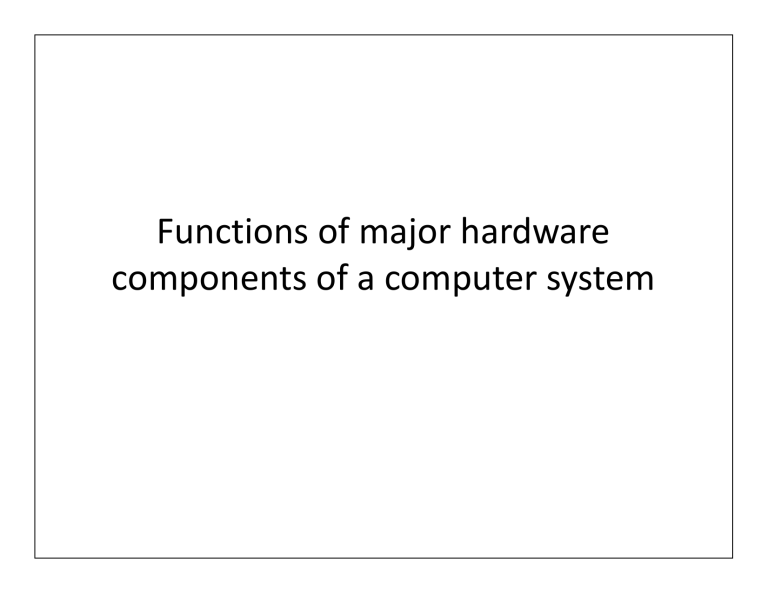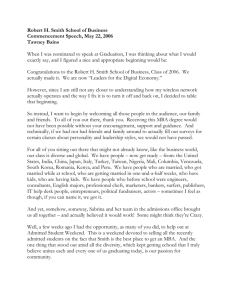Functions of major hardware components of a computer system

Objective
• • Students should be able to:
• • Explain the functions of the major hardware components of a computer system;
Smith
CPU Diagram
Arithmetic Logic Unit (ALU)
Control Unit (CU)
Smith
Central Processing Unit (CPU)
• • Handles the processing of the computer
• • Controls the transfer of data between memory and other devices.
• • Consists of two (2) smaller units – Control Unit
(CU) and Arithmetic Logic Unit (ALU)
Smith
Control Unit
•
•
•
•
This unit controls the overall operations of the CPU.
Directs the operation of components that process the data.
• • Controls the flow of programs and data in and out of primary memory (main memory)
•
•
•
•
Read and interpret program instructions
Control the flow of information to and from all components of the computer.
Control Unit (CU)
Smith
Arithmetic Logic Unit
• • Performs arithmetic operations. These operations include: addition, subtraction,
• • Performs logical operations. These operations include: reasoning and performing the
Arithmetic Logic Unit
(ALU
)
Smith
Primary storage
• • Also referred to as main memory / immediate access storage.
• • Is directly accessible to the CPU
• • Holds data and instructions that are currently being processed (temporary).
• • There are two (2) types of primary storage
(both use chips):
– Random Access Memory (RAM)
– Read Only Memory (ROM)
Smith
Random Access Memory
• • Contents are temporary and are volatile ( lost when the computer is turned off)
• • Stores the instructions and data for currently running programs and the operating system
• • Computer can access data held in RAM immediately
Smith
Read Only Memory
•
•
•
•
Contents are permanent and non-volatile ( not lost when the computer is turned off )
Used to store commands such as those used to boot up the computer.
•
•
•
•
These instructions are read, cannot be changed and are available every time the computer boots up.
These instructions are programmed into the ROM chips by the manufacturer
Smith
Secondary Storage
•
•
•
•
•
•
Also referred to as backing storage or auxiliary storage
Refers to media and methods used to keep programs, data and information available for later retrieval.
Not built on chips. Some examples are:
–
–
–
–
–
Hard disks
Magnetic tape
Floppy disks
Microfilm
CD’s / DVD’s
Smith
Input Devices
• • These devices are used to enter commands and data into the computer
• • Several devices are available each with its own applications, advantages and disadvantages
Smith
Output Devices
• • These devices are used to display information that has been processed to the users.
• • There are two types of output devices:
– Hardcopy (permanent) – it is tangible. E.g. Data printed on paper
– Softcopy (temporary) – such as displays on a screen or speech from a speech synthesizer
Smith
Peripheral Devices
• • A peripheral is a device attached to the computer, but not part of it, and is more or
• • Examples are computer printers, image scanners, tape drives, microphones,
Smith
References
• • Oxford Information Technology for CXC CSEC by
Glenda Gay, Ronald Blades
• • CXC Information Technology by Kelvin Skeete
• • Wikipedia-http://en.wikipedia.org/wiki/Peripheral
Smith








